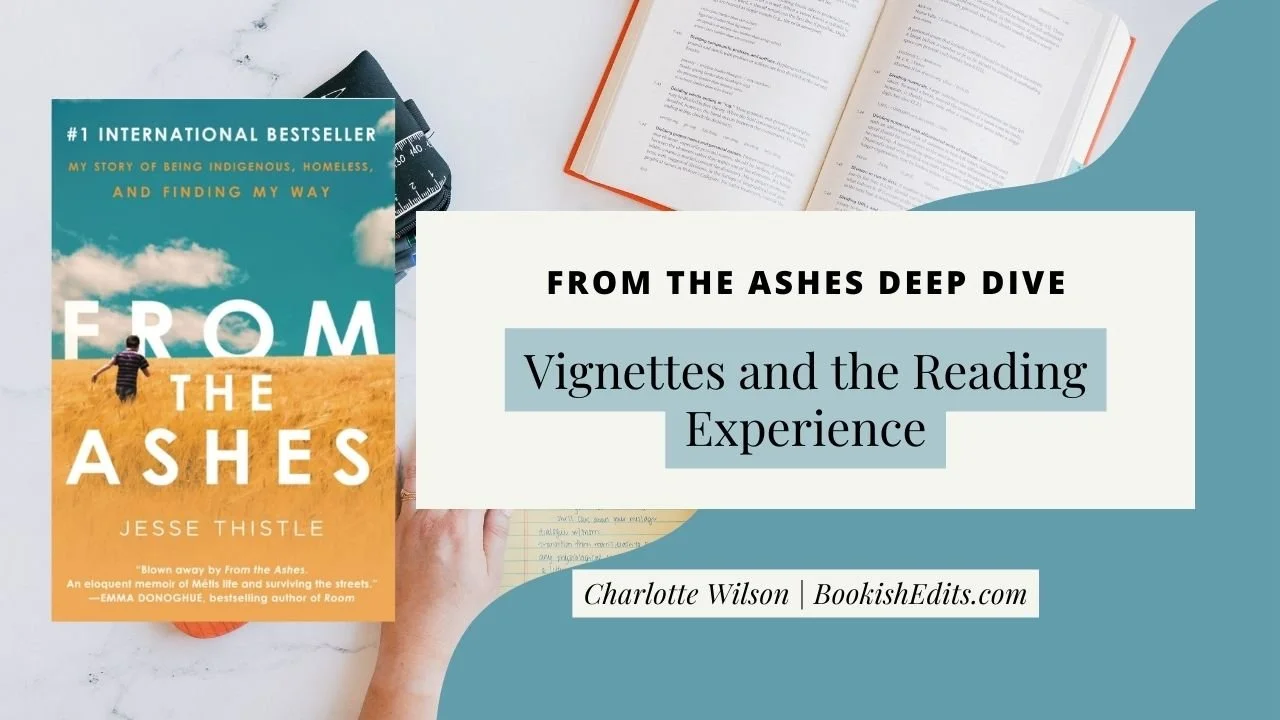Vignettes and the Reading Experience: A Look Inside From the Ashes
The first quarterly read for The Memoir Method Podcast is From the Ashes by Jesse Thistle. This memoir is about a First Nations young man whose first three decades are defined by abandonment, addiction, crime, homelessness, and hopelessness. We’ll spend time over the next three months diving deep into this memoir and identifying what elements make this memoir shine. Most of these podcast conversations will be happening with my friend and fellow reader and writer Ginny Walters.
Vignettes, prose, and essays
You can write a memoir in just about any format you choose, but vignettes, prose, and essays are the most common. A memoir in prose is probably what you think about when you think of any book: an overarching narrative, broken into chapters, that reads as one complete work. Most books, fiction or nonfiction, are written in prose. Memoir in prose can often read as easy as a novel.
Essays on the other hand are contained works connected by a theme. An essay can be a complete work on its own, and can be published as a standalone. You’ll see essays published in magazines like the New Yorker and Atlantic. Writers you find on Substack are typically publishing individual essays. In an essay collection, you’ll find that the essays, while able to be read apart from the other pieces, will be in conversation with them and connected in deeper ways.
Vignettes occupy a distinctly different space, sitting squarely between prose and essays. Vignettes are short snapshots of a life that are also intricately connected to one another. You could probably read one independent of the others, but to be fully understood, they must be read in order and in context of the greater narrative. Vignettes are shorter than the usual essay and, while an effective way to manage the emotions of a reading experience, can risk a choppy reading experience.
Vignettes in From the Ashes
From the Ashes is an intense story that grapples with abandonment, neglect, substance abuse, incarceration, homelessness, and sexual assault. Reading this book took both Ginny and me longer than usual to complete because of how weighty the content is. By writing in vignettes, Jesse Thistle gives his reader frequent places to break, creating room for the reader to set the pace of their reading experience.
Thistle wants to keep the reader reading, and by serving up the narrative into smaller pieces, he gives us permission to go at our own speed. The way he executes these vignettes also enables the reader to reengage and not feel disoriented. Thistle doesn’t employ devices like cliffhangers and creates vignettes that are complete on their own while also being essential to the greater story.
Signaling mood and tone shifts
Vignettes are also an effective way to signal shifts in tone and mood without having to craft smooth transitions (as prose requires). Similar to essays, vignettes allow an author to sink into a mood thoroughly without the need to explicitly pull the reader out. Thistle uses vignettes as signals to the reader, gently noting the ebb and flow of emotional intensity.
This gentle guiding through a serious narrative accomplishes two crucial objectives:
The reader can easily keep going if they want to. The varied tone and mood exployed via the vignettes keeps the reading experience dynamic.
The reader can easily pause if they want to. Using vignettes to shift frequently among moods, characters, and emotional intensity gives the reader ample opportunity walk away without feeling like they’re interrupting the narrative flow. Vignettes used this way create a narrative that, while certainly somber, creates easy entry and exit points.
How you can use vignettes
As you’re deciding which format use in your memoir, you’ll want to first examine what reading experience you want to provide your reader. In From the Ashes, Jesse Thistle crafts a safe environment for his reader to engage in a difficult story; used in a comedic memoir, vignettes can serve the same purpose of giving easy entry and exit points for the reader to dip in for a laugh and then get back to whatever they were doing.
The risk of vignettes is a choppy reading experience that doesn’t draw the reader in. You’ll want to know not only what reading experience you want to give your reader but also the core message of what you want to say. That foundation will root your memoir regardless of the format you write in.
Have you read From the Ashes yet? Head here to see our list of conversations about this book, and I’d love it if you would give the podcast a listen and review.
If you’re wondering whether writing a memoir is the right move for you, you’ll love my free mini ebook, Should You Write a Memoir? You can download that by clicking here.


